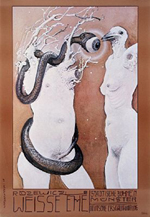When thinking about buying and selling music and films, we often attempt to point to the work of art as separate from the container we buy it in. It’s as though we think one can buy a song without any physical manifestation– perhaps just the ideal of a song. I would contend that reproduced works of art do not exist except for their containers.
This is in contradistinction to original works of art, because they are singular, they are the work itself embodied. This is the unique value of owning and living with real works of art. The viewers relationship is with the work, rather than the means of reproduction. Over time the containers through which we reproduce music and film have changed. From a business perspective, it has been effective to have each work recorded on to a small portable format that can be packaged and sold.
As the methods of reproduction change, the recording formats change– and we buy the next container. It’s at this point that you’ll generally hear the complaint that a particular piece of music has been purchased in many formats over the years. But of course, that’s all there is. There is no recorded music outside of the containers in which it’s sold. To hear actual music one would need to attend a performance.
We’re currently seeing the transition from a physical container to the digital container. Suddenly the purchaser owns a master file than can be placed on multiple devices and copied on to material formats like DVD and CD. This radically changes the economics of the entertainment business. The business used to be the production and sale of units. Marketing and distribution were keys to success.
We can see from examples like Google and Facebook that providing the entry and orientation point for the Internet can be highly lucrative. If a user chooses to pass through your site on her way to any and every destination, you can change a small fee for billboards on that road. A small fee combined with the volume of traffic that passes through Google equals a compelling business.
No company or product has emerged that holds an analogous position to recorded entertainment product. The leading contenders are probably Apple’s iTunes, TiVo and probably Amazon. The “recording industry” is busy defending the old model in the courts. This is a classic sign of the end of a business model cycle. Unable to compete in the markets, they turn to the law to encode their models (See buggy whips).
As the container as format moves to the digital, a new container emerges. The player is now the thing. It’s the iPod, the iPhone, the laptop, the television, the car stereo, the satellite radio player that is the other new ground for innovation. Two good examples of this are the Chumby and Dave Winer’s new FlickrFan. The television is a much more flexible output device in the age of HD flat screens, and Chumby is a classic simplification play. The iPhone and multi-touch creates an almost unlimited platform for software created user interfaces; freed from mechanical user interfaces (KVM) the field is open.
Organizing, curating, editing, programming, sequencing, suggesting, categorizing, collecting on a theme: these are the value propositions in the new landscape. Can it be done algorithmically? Should it be? Amazon often provides comical suggestions based on the attention and gesture data they’ve collected. Steve Gillmor has created an iPhone site that filters news based on sets of selected editors (professional and amateur). Jason Calacanis and Mahalo are attempting to provide curated search results, but maybe search isn’t the thing that people are really looking for. Maybe it’s the curation itself.


